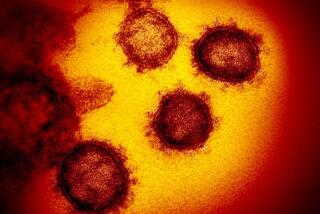Cell Engineering Could Lead to AIDS Therapy
- Share via
A new technique in which individual cells are “immunized” against viral infection by genetic engineering techniques could eventually help provide a new therapy for AIDS and herpes, researchers report today in the British journal Nature.
In an unusual approach, geneticists at the Carnegie Institution of Washington engineered mouse white blood cells so that they produced an altered version of a protein that is crucial to proliferation of the herpes virus in the cells.
When the laboratory-grown cells began producing the altered protein, which will not support viral proliferation, the cells could no longer be infected by the herpes virus.
‘Ideal Target’
In an accompanying commentary, Nobel laureate David Baltimore of the Massachusetts Institute of Technology named the new technique “intracellular immunization” and said that AIDS would be an ideal target for this approach using a comparable protein from the AIDS virus. The AIDS virus infects white blood cells, which would be the easiest human cells to engineer, he said.
Microbiologist Arnold J. Berk of UCLA said the Carnegie work is an “interesting” approach that “may have great potential,” but he cautioned that the technique has many hurdles to overcome before it could even be considered for use in human therapy. The most important of these hurdles, he noted, is that the engineered genes have never been successfully inserted into human blood cells.
Nonetheless, Baltimore said, “given the difficulty of standard immunization against (the AIDS virus) and the problems of designing good therapeutic agents, I believe intracellular immunization has as good a chance as any other procedure of becoming a real AIDS therapy.”
The new technique was developed by geneticists Steven L. McKnight, Alan D. Friedman and Steven J. Triezenberg of Carnegie’s Baltimore laboratory, who were not looking for an acquired immune deficiency syndrome cure but for a new way to study how genes are turned on and off in growing cells. They were studying viruses because during the first stages of an infection, the viruses must activate their own genes and certain genes of the infected cell.
Each herpes virus, McKnight said in a telephone interview, carries a protein called VP16 that combines with a protein in the cell it attacks to activate five of the virus’s 75 genes. The proteins made by these five genes then initiate the reproductive process.
In one series of experiments, the researchers made a mutated form of VP16 by removing some of its amino acids. To their surprise, they found that the mutated protein not only lost its ability to trigger viral replication in the mouse cells but was also able to prevent normal VP16 from doing so.
McKnight believes that the altered VP16 protein blocks the normal protein from attaching to the five genes that would normally activate proliferation.
White Cells
The group then inserted the gene for the altered VP16 protein into mouse white cells, where the altered protein was produced. These cells, Baltimore said, are then “remarkably well protected from infection.” But the protection extends only to herpes viruses. Other viruses infect the cells normally.
Interestingly, a similar phenomenon has been observed in plants. Researchers have “immunized” tobacco plants, for example, by inserting the gene for a protein of tobacco mosaic virus into their cells. The plant can then not be infected. The mechanism for this protection is as yet unknown.
Baltimore speculated that a similar approach could be used to treat AIDS. Using a process that has frequently been proposed for therapy of genetic diseases, stem cells--bone marrow cells that produce white blood cells--would be removed from individuals infected with the AIDS virus.
The gene for an AIDS protein that initiates proliferation would be inserted into the stem cells, which would then be returned to the bone marrow after all the patient’s other stem cells had been killed by radiation.
As the stem cells proliferated, their progeny would be immune to the AIDS virus, and the infection would be halted.
Paving the Way
The problem with this approach, according to W. French Anderson of the National Institutes of Health, is that researchers have not yet been able to make the inserted genes function properly in stem cells. But many scientists believe that this problem will eventually be overcome, Berk noted, paving the way for both gene therapy and AIDS therapy.
McKnight, meanwhile, is trying to develop engineered mice in which all the cells are immune to herpes viruses but does not plan to study the AIDS virus.
“We just want to understand gene regulation in the system,” he said. “But there are plenty of people studying gene regulation in the AIDS virus, and I would not be surprised if some of them were trying to do this same thing already.”





